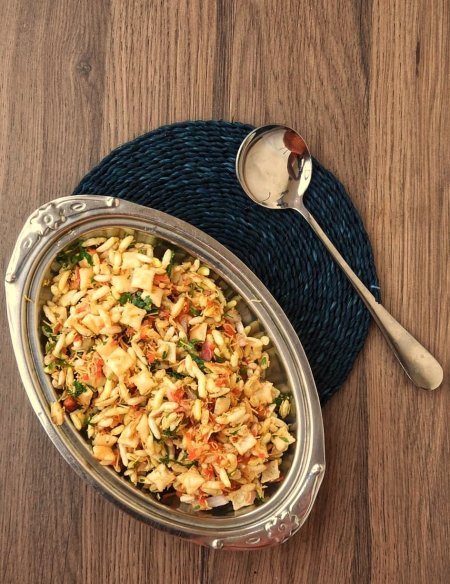The recipe I am going to share with you today comes from Manipur, an Indian region I have always been fascinated by. Apart from its beautiful valleys and lush forests, sprawling grasslands and caves, the state has a rich cultural heritage too. Manipur is also home to black rice, Chak Hao in the local language, an interesting ingredient I have just begun experimenting with. I chose to use it to prepare Chak Hao Amubi, or a Manipuri Black Rice Pudding (Kheer), and was absolutely thrilled with the way it turned out.
The cuisine of Manipur is very simple, the dishes making use of minimal ingredients. The cuisine is largely non-vegetarian, with quite a few vegetarian dishes on offer too. A variety of local vegetables and greens are used in Manipuri cooking, mostly grown organically. The food is spiced up with local chillies, flavoured with any of the several aromatic herbs that grow in abundance here. The traditional Chak Hao Amubi is reflective of the state’s culinary philosophies too – it is made with minimal ingredients, allowing the nutty flavour of the black rice to shine through. I have made the kheer with a few little variations of my own, though, to suit my family’s taste buds.

Like I was saying earlier, the Black Rice Pudding turned out absolutely brilliant. The black rice, with its unique flavour profile, worked beautifully with the milk and sugar in the pudding. A much healthier alternative to the regular white rice, it lent the pudding a pretty, pretty purple hue too. In terms of both looks and taste, this Black Rice Kheer was a huge hit with everyone at home!
Here’s how I made the Chak Hao Amubi or Black Rice Pudding.
Ingredients (serves 4-5):
- 1/4 cup black rice
- 1 litre full-fat milk (+ a little extra if needed)
- 1/2 cup sugar or as per taste
- 2-3 pinches cardamom powder (optional)
- About 1 tablespoon ghee (optional)
- 5-6 cashewnuts (optional)
- 5-6 almonds (optional)
- Dried rose petals as needed for garnishing (optional)
Method:
1. Wash the black rice once in running water. Drain out the excess water. Add in just enough fresh water to cover it, and let it soak for 8-10 hours or overnight.
2. Once the black rice is done soaking, drain out the excess water from it. Keep ready.
3. Take 1 litre of full-fat milk in a heavy-bottomed pan, and place on high heat. Let the milk come to a boil.
4. Lower the flame to low-medium. Add the soaked and drained black rice to the milk in the pan. Mix well.
5. Cook on low-medium heat till the rice is cooked through, 25-30 minutes. You will need to stir intermittently, to prevent sticking to the bottom of the pan, and scrape down the cream that forms on the sides of the pan.
6. Now, add sugar to the pan. Mix well. Simmer the Black Rice Pudding for a couple of minutes more. Switch off gas.
7. Mix in the cardamom powder to the pudding, after the flame has been switched off.
8. Chop the cashewnuts and almonds into slivers. Heat the ghee in another pan. Reduce flame and add the cashewnut and almond slivers. Allow them to brown slightly, ensuring that they do not burn. Switch off the gas, and add the ghee, cashewnuts and almonds to the Black Rice Pudding. Mix well.
9. Serve the Black Rice Kheer hot, at room temperature or chilled, garnished with dried rose petals.
Notes:
1. Black rice is quite tough, and typically needs a soaking time of 8-10 hours. However, there are some versions that need to soak for just 2-3 hours or so. Ensure that you read the package instructions carefully, to check on the exact cooking proceedure for the black rice you are using. The one I got, from our recent travel to Thailand, needed to soak overnight.
2. Use good-quality full-fat milk, for best results. Here, I have used Nandini Full-Cream milk.
3. Adjust the quantity of sugar you use, depending upon personal taste preferences.
4. To check doneness of the rice, try tasting a couple of the grains – they will still be a bit hard on the outside, but will be soft and cooked on the inside. Like I said earlier, it takes around 25-30 minutes for the black rice to cook in the milk.
5. If you feel the kheer is getting too thick but the rice is not yet cooked, you can add in some more boiled milk. In this case, you will need to re-adjust the quantity of sugar you need.
6. The original Chak Hao Amubi or Black Rice Kheer in Manipur is a very simple affair, made with just milk, black rice and sugar (often, with jaggery or honey as the sweetener). Occasionally, a couple of pinches of cardamom powder are used to liven it up. Using the cardamom is purely optional – I would suggest using it, though, for it adds a lovely touch to the kheer.
7. I have used ghee-roasted cashewnuts and almonds in the Chak Hao Amubi, as well as dried rose petals, to make it more inviting. Using these ingredients is purely optional.
8. I have used only 1/4 cup of rice here, as I wanted the kheer to be runny. You can adjust the quantity of black rice and milk (and sugar, of course), depending upon how thick you want the kheer to be.
9. Check out this old post of mine for another lovely recipe using black rice, and some interesting facts about this very healthy ingredient.
************
This recipe is for the Shhhh Cooking Secretly Challenge that I am part of. Every month, the participants of the group cook dishes from a particular part of India, using two secret ingredients assigned to them. This month, all of us over are cooking dishes from the Indian state of Manipur.
I was paired with Bhawana of Code2Cook for this month, who assigned to me the two secret ingredients of black rice and sugar. I decided to make Manipur’s Chak Hao Amubi using these two ingredients. Check out the amazing Vegan Sana Thongba or Vegan Manipuri Paneer Curry that Bhawana made using the two ingredients I gave her – cumin and milk!
I’m also sharing this recipe with Fiesta Friday #261. The co-hosts this week are Antonia @ Zoale.com and Julianna @ Foodie on Board.






